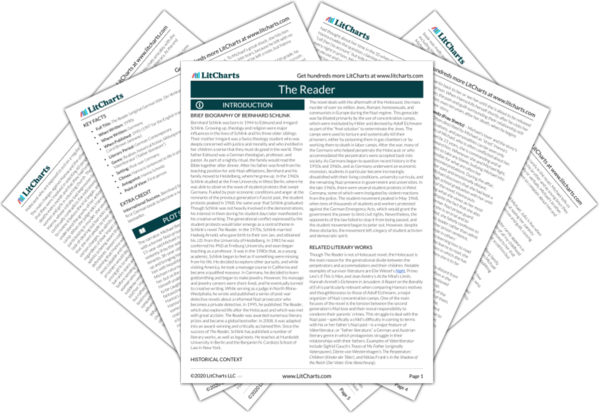Guilt, Responsibility, and the Holocaust
The primary concern of the novel is guilt about the Holocaust. Examining the role of guilt in post-war Germany, The Reader presents guilt as a pervasive and inevitable force. An important motif running throughout the story is the question of who must be held responsible for atrocities committed during the Holocaust. Michael and his generation lay blame on not only the Nazi perpetrators but also the bystanders — the previous generation who looked the other…
read analysis of Guilt, Responsibility, and the HolocaustSecrets, Indifference, and Emotional Distance
Indifference and emotional distance are near constant presences in Michael’s and Hanna’s lives. As the novel moves forward, we learn that part of this distance is caused by the secrets they keep from those around them. When Michael tries to keep his relationship with Hanna a secret, he becomes increasingly distant from his friends and family. For example, after returning home from sleeping with Hanna for the first time and lying about where…
read analysis of Secrets, Indifference, and Emotional DistanceGenerational and Parent-Child Conflict
The novel, which is deeply concerned with guilt, explores the tension that collective guilt creates between parents and children. The generation of Michael’s parents, as well as that of Hanna, is a “generation of perpetrators, voyeurs, and the willfully blind, accommodators and accepters.” Their children face the uncomfortable question of whether they too are complicit by loving their parents, and therefore accepting the previous generation’s crimes. Michael and his peers “condemned [their] parents…
read analysis of Generational and Parent-Child Conflict
Reading and Illiteracy
The novel presents the inability to read as a form of dependence. Hanna’s illiteracy severely limits her options, determining the course of her life. Because she is unable to read, she is forced to decline promotions and must resort to jobs she views as “idiotic.” Not only does Hanna’s illiteracy limit her life choices, but her shame for being illiterate pushes her to make certain choices to hide her secret. These choices — her…
read analysis of Reading and IlliteracyThe Image as Memory and the Gaze
A recurring motif in the novel is the idea that images function as memory. For example, Michael remembers a younger Hanna through “pictures” on a “mental projector,” and for post-Holocaust Germany, images of Nazi atrocities “derived from Allied photographs and the testimony of survivors” become part of the nation’s collective memory, serving as both a record of knowledge and a warning to avoid past mistakes. As a law student, Michael and his classmates use the…
read analysis of The Image as Memory and the Gaze











